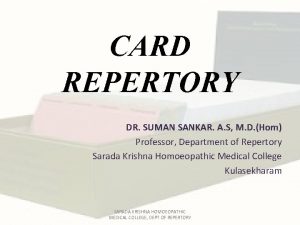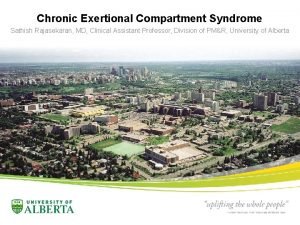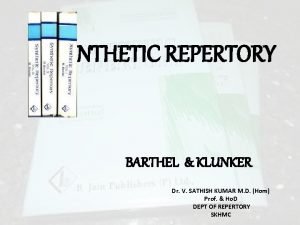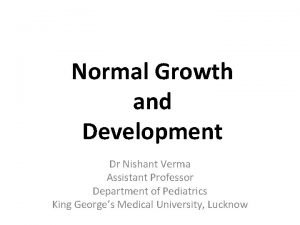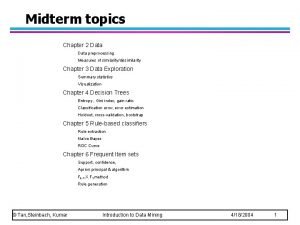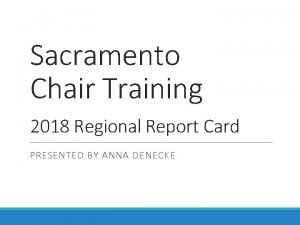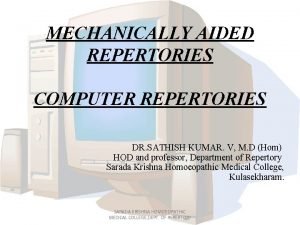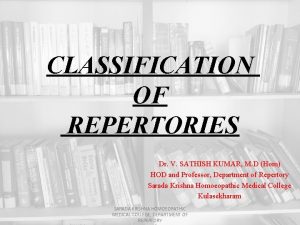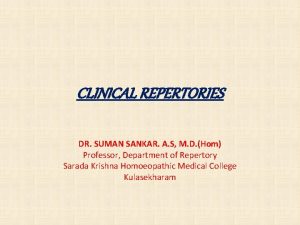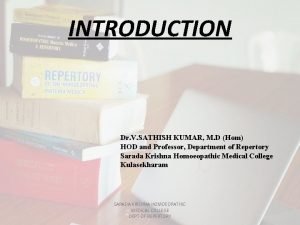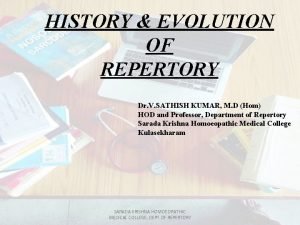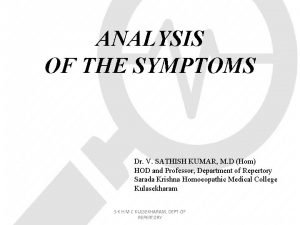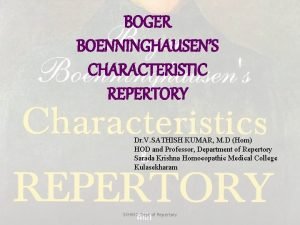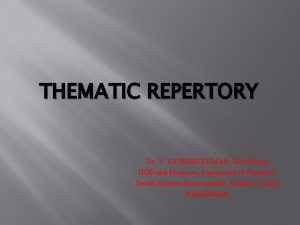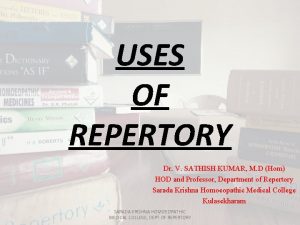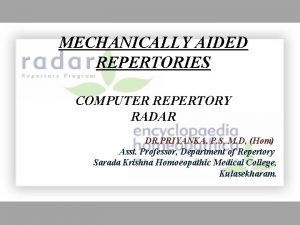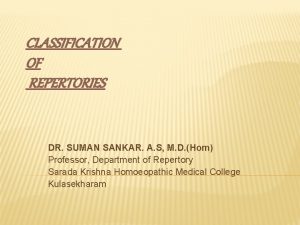CLINICAL REPERTORIES Dr V SATHISH KUMAR M D

















- Slides: 17

CLINICAL REPERTORIES Dr. V. SATHISH KUMAR, M. D (Hom) HOD and Professor, Department of Repertory Sarada Krishna Homoeopathic Medical College Kulasekharam SARADA KRISHNA HOMOEOPATHIC MEDICAL COLLEGE, DEPT OF REPERTORY

DEFINITION OF CLINICAL REPERTORIES • Clinical repertories are those repertories which contain clinical symptoms/conditions and corresponding group of medicines. • These repertories facilitate the selection of a remedy on the basis of pathological similarity, causation, modalities and concomitants. SARADA KRISHNA HOMOEOPATHIC MEDICAL COLLEGE, DEPT OF REPERTORY

• They are not commonly used for the purpose of repertorization. However, these repertories can be used for repertorization of cases where clinical conditions mask the characteristics of the patient. • In such cases the physician finds the prominent common symptoms with a few modalities and concomitants. These cases need the help of clinical repertories for selecting the simillimum SARADA KRISHNA HOMOEOPATHIC MEDICAL COLLEGE, DEPT OF REPERTORY

ORIGIN OF CONCEPT OF CLINICAL REPERTORIES • In spite of emphasis on individualization and prescription based on characteristic expressions, the emergence of clinical repertories could not be prevented in homoeopathic practice as early as Hahnemann’s time. • The grouping of the medicines according to the name of diseases, though discouraged by many stalwarts has given birth to clinical repertories. SARADA KRISHNA HOMOEOPATHIC MEDICAL COLLEGE, DEPT OF REPERTORY

ORIGIN OF CONCEPT OF CLINICAL REPERTORIES (Contd…) • The greatest modern exponent of this practice is the late Dr J. Crompton Burnett, who has brought once more to light the vast therapeutic treasures which had been allowed to lie forgotten in the works of the great masters. • The use of nosological correspondence is one method bymeans of which a similar, if not the most similar, remedy may be discovered. SARADA KRISHNA HOMOEOPATHIC MEDICAL COLLEGE, DEPT OF REPERTORY

ORIGIN OF CONCEPT OF CLINICAL REPERTORIES (Contd…) • All ways of finding indications are open to practitioners and the clinical avenue is one of them. • J. H. Clarke has described it like this, “Certain diseases come to have certain remedies assigned to them and all the patients who are found to be suffering from any given disease must be dosed with one of the remedies credited to it. ” • Master Hahnemann was certainly not happy with such kind of practice; he described it as, “Treating the names of the diseases with names of therapeutic actions”. SARADA KRISHNA HOMOEOPATHIC MEDICAL COLLEGE, DEPT OF REPERTORY

ORIGIN OF CONCEPT OF CLINICAL REPERTORIES(Contd…) • Such a kind of practice was much favoured by Dr J. Crompton Burnett. • He expresses it as, “The fact is we need any and every way of finding the right remedy; the simple simile, the simple symptomatic similimum and the farthest reach of all – the pathologica similimum, and I maintain that we are still within the lines of Homoeopathy that is an expansive, progressive, science. ” SARADA KRISHNA HOMOEOPATHIC MEDICAL COLLEGE, DEPT OF REPERTORY

ORIGIN OF CONCEPT OF CLINICAL REPERTORIES (Contd…) • As early as in 1869 Bell’s diarrhea and in 1873 Berridge’s Eye, two very useful clinical regional repertories were published. • Though the concept of such practice was conceived by Burnett he could not compile separate repertory for that purpose and hence the credit for authoring the first useful Clinical Repertory goes to J. H. Clarke. SARADA KRISHNA HOMOEOPATHIC MEDICAL COLLEGE, DEPT OF REPERTORY

ORIGIN OF CONCEPT OF CLINICAL REPERTORIES (Contd…) • Though many Clinical Repertoires are available these days, tow of them are well known as General Clinical Repertory. They are – A Clinical Repertory by J. H. Clarke and Materia Medica with Repertory by O. E. Boericke. • There are many useful Regional Clinical Repertories which help the practitioners to find a similar remedy. SARADA KRISHNA HOMOEOPATHIC MEDICAL COLLEGE, DEPT OF REPERTORY

CLINICAL REPERTORIES These repertories have many clinical rubrics under different systems, and medicines are grouped against the name of disease. They are sub – divided as follows: (a) Covering the whole: E. g. Boericke’s Materia Medica with Repertory, Clarke’s Repertory. (b) Covering the regions: They deal with the disease condition or a part. E. g. On Special parts. Berridge’s Eyes. Morgan’s Urinary Organs Minton’s Uterus On Clinical Conditions – Robert’s Rheumatic Medicines Bell’s Diarrhea Allen’s Repertory of. HOMOEOPATHIC Intermittent Fever. SARADA KRISHNA MEDICAL COLLEGE, DEPT OF REPERTORY

SCOPE AND LIMITATION Though clinical repertories have not been put to their fullest utility, these can be very useful too if the scope and limitations are properly understood and implemented in practice. SARADA KRISHNA HOMOEOPATHIC MEDICAL COLLEGE, DEPT OF REPERTORY

SCOPE • Clinical repertories can be used in the study of Homoeopathic Therapeutics as well as Materia Medica. • They help to repertorize the following types of cases: – Cases lacking in mental generals and physical generals but rich in common symptoms. – Cases with clinical diagnosis. – Short cases with a few symptoms. SARADA KRISHNA HOMOEOPATHIC MEDICAL COLLEGE, DEPT OF REPERTORY

SCOPE (Contd…) • They are used as quick reference books at the bed-side. • Clinical repertories contain some rubrics, which are not found in other general repertories; therefore they can become a good companion in the study of such rubrics. SARADA KRISHNA HOMOEOPATHIC MEDICAL COLLEGE, DEPT OF REPERTORY

SCOPE (Contd…) • Clinical repertories help us to find the most appropriate palliative medicine in incurable cases. • Regional repertories help in finding out the simillimum in a specific clinical condition. SARADA KRISHNA HOMOEOPATHIC MEDICAL COLLEGE, DEPT OF REPERTORY

LIMITATION • Clinical repertories are based on nosological terms and clinical symptoms, which are the result of clinical observations hence their use is limited to particular type of cases. They are mainly used for reference work. SARADA KRISHNA HOMOEOPATHIC MEDICAL COLLEGE, DEPT OF REPERTORY

References • A Clinical Repertory by J. H. Clarke • Materia Medica with Repertory by O. E. Boericke. • A reference to repertories for homoeopathic students-Dr. SIJU. P. V • Essentials of repertorisation-Dr. SHASHI KANT TIWARI SARADA KRISHNA HOMOEOPATHIC MEDICAL COLLEGE DEPT OF REPERTORY

SARADA KRISHNA HOMOEOPATHIC MEDICAL COLLEGE DEPT OF REPERTORY
 Card repertories
Card repertories Sathish rajasekaran
Sathish rajasekaran Synthetic repertory pdf
Synthetic repertory pdf Musculoskeletal surgery ayr
Musculoskeletal surgery ayr Dr pulin kumar
Dr pulin kumar G ravindra kumar
G ravindra kumar Tan steinbach kumar
Tan steinbach kumar Vikas kumar
Vikas kumar Dr nishant verma
Dr nishant verma Association analysis advanced concepts
Association analysis advanced concepts Pavan kumar vijay
Pavan kumar vijay Chapter 9 kumar steinbach tan
Chapter 9 kumar steinbach tan Sunesh kumar
Sunesh kumar Akshay kumar
Akshay kumar Swarun kumar
Swarun kumar Ranjana kumar
Ranjana kumar Ravi kumar sacramento
Ravi kumar sacramento Arwin kumar
Arwin kumar
